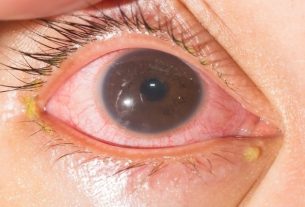Tuberculosis is an infection caused by bacteria Mycobacterium tuberculosispopularly known as Koch’s bacillus (BK), which mainly affects the lungs, leading to symptoms such as a dry, bloody cough, chest pain and difficulty breathing.
The bacillus enters the body through the upper airways, through the inhalation of droplets of saliva or nasal secretions released when an infected person coughs, sneezes or speaks, and, although it is more common to cause infection in the lung, it can also affect other organs, such as kidneys, bones or brain, for example, resulting in symptoms such as bone pain, blood in the urine or headache.
It is important to consult an infectious disease specialist or general practitioner as soon as the first symptoms suggestive of tuberculosis appear, as this makes it possible to start early treatment, which is usually done with a combination of antibiotics.

Tuberculosis symptoms
The main symptoms of tuberculosis are:
- Cough with or without blood;
- Persistent cough for more than 3 weeks;
- Weight loss for no apparent reason;
- Chest pain when coughing or breathing;
- Difficulty breathing;
- Excessive tiredness;
- Low fever;
- Chills;
- Night sweats.
These symptoms are more common when the bacteria develops in the lungs.
Furthermore, when the bacteria develops in other organs, such as the kidneys, brain or spine, other symptoms may appear, such as swelling where the bacteria is located, back pain or the presence of blood in the urine. Learn about other symptoms of tuberculosis.
How to confirm the diagnosis
The diagnosis of tuberculosis, as well as the type of tuberculosis, is made by the infectious disease specialist or general practitioner according to the symptoms presented by the person and test results, as this means that appropriate treatment can be initiated to combat the bacteria and, thus, , prevent the development of the disease and the emergence of complications.
Make an appointment with the infectious disease specialist in the region closest to you:
Taking care of your health has never been easier!
In the case of pulmonary tuberculosis, the diagnosis can be made by performing a chest X-ray and examining the sputum with tuberculosis bacillus testing, also called AFB testing (Alcohol-Acid Resistant Bacillus).
To diagnose extrapulmonary tuberculosis, it is recommended to perform a biopsy of the affected tissue. You can also perform a tuberculin skin test, also known as a skin test. Mantoux or PPD, which is negative in 1/3 of patients. Understand how PPD is done.
Learn more about tuberculosis, its types and how it is diagnosed in the following video:
Types of tuberculosis
According to the place where the tuberculosis bacteria settles and develops, tuberculosis can be classified into some types, the main ones being:
1. Pulmonary tuberculosis
Pulmonary tuberculosis is the most common form of the disease and occurs due to the bacillus entering the upper respiratory tract and lodging in the lungs.
This type of tuberculosis is characterized by a dry and constant cough with or without blood, with coughing being the main form of contagion, as the droplets of saliva released through coughing contain Koch’s bacilli and can infect other people.
2. Tuberculosis billion
Miliary tuberculosis is one of the most serious forms of tuberculosis and occurs when the bacillus enters the bloodstream and reaches all organs, posing a risk of meningitis.
In addition to the lung being seriously affected, other organs can also be affected, such as the liver, bone marrow, brain, spinal cord or the membrane that surrounds the heart, for example.
3. Bone tuberculosis
Bone tuberculosis, although it is not very common, it occurs when the bacillus manages to penetrate and develop in the bones, which can cause pain and inflammation, which is not always initially diagnosed and treated as tuberculosis. Check out the main symptoms of bone tuberculosis.
4. Ganglionic tuberculosis
Nodal tuberculosis is caused by the entry of the bacillus into the lymphatic system, which can affect lymph nodes in the chest, groin, abdomen or, more frequently, the neck.
This type of extrapulmonary tuberculosis is not contagious and can be cured when treated correctly. See how lymph node tuberculosis is treated.
5. Tuberculose pleural
Pleural tuberculosis occurs when the bacillus affects the pleura, the tissue that lines the lungs, causing intense difficulty in breathing. See other symptoms of pleural tuberculosis.
This type of extrapulmonary tuberculosis is not contagious, however, it can be acquired when coming into contact with a person with pulmonary tuberculosis or be a progression of pulmonary tuberculosis.
6. Tuberculose cerebral
Cerebral tuberculosis or neurotuberculosis is caused by the entry of the bacillus into the central nervous system, which can result in meningitis or encephalopathy, and symptoms such as headache, stiff neck, vomiting or even convulsions.
7. Tuberculose intestinal
Intestinal tuberculosis occurs when the bacillus manages to reach the intestine, whereby a person with active pulmonary tuberculosis swallows contaminated phlegm, resulting in symptoms such as abdominal pain or swelling, diarrhea or fever. Check out other symptoms of intestinal tuberculosis.
In addition, intestinal tuberculosis can also be transmitted through the spread of the bacillus through the blood or lymph nodes or even through the ingestion of unpasteurized raw cow’s milk or dairy products contaminated with the tuberculosis. Mycobacterium bovis.
8. Tuberculose ocular
Ocular tuberculosis occurs when the bacteria Mycobacterium tuberculosis, present in the lungs, spreads through the blood reaching the eye, or directly infects the eyes. Furthermore, it can also arise due to an immunological response in the structures of the eye after exposure to tuberculosis antigens.
This type of tuberculosis can affect both the internal structures of the eye, as well as the eternal structures, such as the eyelids, eye socket, lacrimal gland, sclera or cornea, for example.
The most common symptoms of ocular tuberculosis are redness in the eyes, headache, floaters, decreased vision or increased sensitivity to light, and affecting one or both eyes. Check out the main symptoms of ocular tuberculosis.
9. Genitourinary tuberculosis
Genitourinary tuberculosis occurs when the bacillus disseminates into the blood during the initial pulmonary infection, remaining inactive in the genital and/or urinary tract, being reactivated when the immune system is weakened.
Furthermore, other forms of transmission are through the lymphatic system or intimate contact.
Symptoms of genitourinary tuberculosis are fever, night sweats, loss of appetite or weight, or recurrent urinary infections that do not respond to antibiotic treatment.
10. Tuberculosis in the spine
Spinal tuberculosis, known as Pott’s disease, occurs when bacteria Mycobacterium tuberculosis It spreads through the blood, especially when pulmonary tuberculosis is not treated correctly, reaching the spine.
Generally, the bacillus remains inactive for a long time, however, when the immune system is weakened, it can be reactivated and multiply.
Spinal tuberculosis causes an inflammatory reaction at the site and progressive destruction of the spinal vertebrae, causing symptoms such as back pain, leg weakness, spinal abscess or kyphosis, for example.
How transmission happens
Tuberculosis can be transmitted through the air, from person to person, through the inhalation of infected droplets released through coughing, sneezing or talking. Transmission can only occur if there is lung involvement and up to 15 days after starting treatment.
People who have a compromised immune system due to disease or age, who smoke and/or consume drugs are more likely to be infected by the tuberculosis bacillus and develop the disease.
Prevention of the most serious forms of tuberculosis can be achieved through the BCG vaccine in childhood. Furthermore, it is recommended to avoid closed, poorly ventilated places with little or no sun exposure, but it is essential to stay away from people diagnosed with tuberculosis. See how tuberculosis is transmitted and how to prevent it.
How the treatment is carried out
Tuberculosis treatment is free, and therefore, if a person suspects they have the disease, they should seek hospital or health center immediately.
Treatment consists of the use of tuberculostatic medications for approximately 6 months in a row or as advised by an infectious disease specialist. In general, the initial treatment regimen indicated for tuberculosis is the combination of rifampicin, isoniazid, pyrazinamide and ethambutol.
Read too: 4×1 medicine for tuberculosis: what it is and how it works
For the first 15 days of treatment, the person must remain isolated, as they can still transmit the tuberculosis bacillus to other people. After this period, you can return to your normal routine and continue using your medications. Understand how tuberculosis is treated.
Home remedy options
Home remedies for tuberculosis, such as drinking about 2 liters of water a day, nebulizing or drinking basil tea or ginger tea, can help relieve a cough or fever, for example.
These home remedies can be used to complement the treatment recommended by the doctor, not replace it, as to eliminate the bacteria it is necessary to use antibiotics for around 6 months in a row. See all home remedy options for tuberculosis.
Is tuberculosis curable?
Tuberculosis can be cured when treatment is carried out correctly according to the doctor’s recommendations.
The treatment time is around 6 consecutive months, which means that even if the symptoms disappear in 1 week, the person must continue taking the medication until the 6 months are complete.
If this does not happen, the tuberculosis bacillus may not be eliminated from the body and the disease may not be cured, in addition, there may be bacterial resistance, which makes treatment more difficult. See how to achieve a cure for tuberculosis.
How to prevent
The main way to prevent tuberculosis is to take the BCG vaccine, which is part of the baby’s vaccination schedule and is administered in the hospital shortly after birth.
Read too: Baby vaccination schedule 2024: from birth to 4 years
Furthermore, you should avoid contact with people infected with the bacillus, wear a mask, always cover your nose and mouth when coughing or sneezing and keep your house ventilated at all times, as the bacillus can remain in the air for many hours.

Sign up for our newsletter and stay up to date with exclusive news
that can transform your routine!
Warning: Undefined array key "title" in /home/storelat/public_html/wp-content/plugins/link-whisper-premium/templates/frontend/related-posts.php on line 12
Warning: Undefined array key "title_tag" in /home/storelat/public_html/wp-content/plugins/link-whisper-premium/templates/frontend/related-posts.php on line 13



